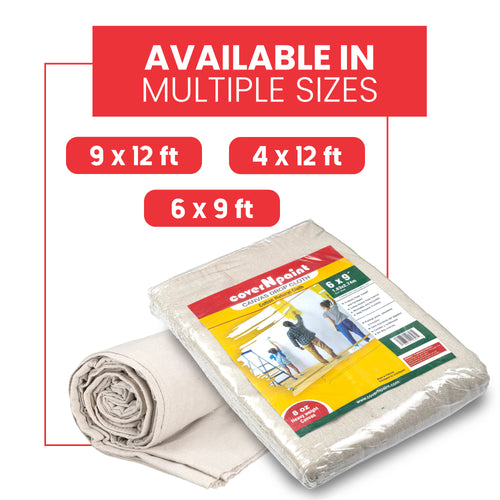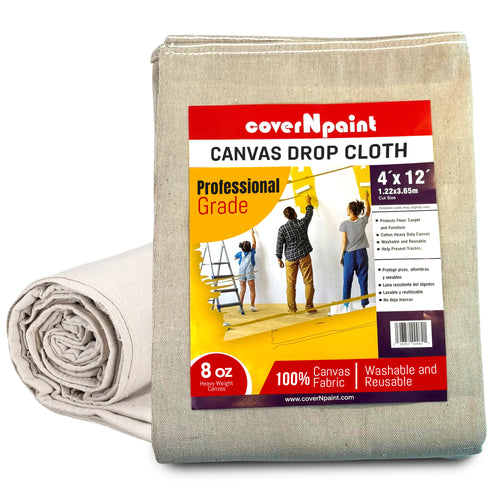Understanding the Water-Blocking Potential of Canvas:
Drop cloths made of canvas are typically not completely waterproof. They are made of cotton that is tightly woven and offer decent protection from dust and paint spills, although they tend to absorb water instead of repel it. Moisture may leak through the cloth as a result of this absorption, particularly in situations that are consistently damp. You can use a waterproofing spray or coating, like a silicone or wax-based substance, to make canvas drop cloths water-resistant. By forming a surface barrier, this treatment increases the cloth's ability to ward against moisture. Canvas drop cloths, even after treatment, are usually not appropriate for complete waterproofing in rainy conditions or during periods of high precipitation. Instead, use plastic sheeting or specialty waterproof tarps for dependable water protection.
- Water-Blocking Potential: Canvas drop cloths are often evaluated based on weight or thickness, which affects their water resistance.
- Dense Weave for Better Protection: Heavier canvas has a denser weave, enhancing protection against water penetration.
- Ideal for High Water Resistance Needs: Heavyweight canvas drop cloths are preferred when significant water resistance is required.
- Consider Portability: Heavier cloths can be more cumbersome to handle and store, so balance water resistance needs with ease of use.
- Informed Decision-Making: Understanding canvas water-blocking potential helps choose the right drop cloth for specific project needs.
A Closer Look at Canvas Drop Cloths and Waterproofing:
A closer look at canvas drop cloths and waterproofing unveils the intricate relationship between the material's natural properties and external treatments. Canvas, often crafted from cotton or a blend of cotton and polyester, naturally has breathability and absorbency as inherent qualities. This porosity is advantageous in certain applications, such as allowing surface breathing during painting projects. However, it also means that untreated canvas may not be completely impervious to water, making it essential to consider the specific use case and environmental conditions.
- Waterproofing Techniques: Canvas drop cloths can be waterproofed using specific coatings or treatments to enhance moisture resistance.
- Common Treatments: Wax coatings, silicone-based sprays, and synthetic water repellents are popular for creating a water-resistant barrier.
- Hydrophobic Barrier: These treatments make the canvas surface hydrophobic, allowing water to bead up instead of being absorbed.
- Effectiveness and Maintenance: Waterproofing treatments may vary in effectiveness, and regular reapplications are often needed to sustain water repellency.
- Purpose-Driven Selection: When choosing canvas drop cloths, consider the intended use and select treatments that align with project demands, such as painting or outdoor protection.
Waterproofing Features of Canvas Drop Cloths:
Canvas drop cloths often have various waterproofing features to enhance their performance in diverse settings. These features contribute to the cloth's ability to repel water and protect surfaces during painting, renovations, or outdoor activities. One common method of enhancing waterproofing is through the application of water-resistant coatings. These coatings may include substances like wax, silicone, or synthetic compounds that create a protective layer on the surface of the canvas.
- Reliable Water Resistance: Waterproofed canvas drop cloths prevent moisture from penetrating, offering dependable protection for underlying surfaces in wet conditions.
- Enhanced Protection with Paint Drop Cloths: Protect surfaces effortlessly from spills and splatters; invest in quality drop cloths for a clean, mess-free painting experience.
- Reinforced Seams and Edges: Some drop cloths have extra water-resistant treatments on seams and edges to prevent seepage at these vulnerable points.
- Advanced Textile Technology: Laminated or layered canvas designs provide maximum water resistance, ensuring high protection standards.
- Customizable Waterproofing Options: With various waterproofing features available, users can select canvas drop cloths tailored to specific project demands and environmental needs.
How Canvas Handles Water Challenges
Canvas, renowned for its durability and versatility, faces water challenges with a unique blend of characteristics that make it a popular choice for various applications. The natural fibers in canvas, often derived from cotton or a cotton-polyester blend, inherently possess a degree of water resistance. The tight weave structure of canvas fabric provides a barrier against light moisture, making it a practical choice for activities like outdoor events or drizzles.
- Porosity of Canvas: Canvas is naturally porous and can absorb water, which may lead to saturation under substantial water exposure.
- Specialized Coatings for Water Resistance: Treatments like wax or silicone create a hydrophobic surface on canvas, helping water bead and roll off instead of being absorbed.
- Enhanced Water Repellency: These water-resistant treatments are ideal for applications such as canvas drop cloths, protecting surfaces from paint spills and rain.
- Understanding Canvas Properties: Recognizing both the natural characteristics of canvas and the benefits of waterproofing treatments helps users tackle water challenges effectively.
- Informed Decision-Making: Knowledge of canvas’s water-handling capabilities and available treatments enables users to choose the right product for their specific project needs.
Best Quality Canvas Drop Cloth | Same Day Dispatch | Order Now
Assessing the Waterproof Credentials of Canvas
Assessing the waterproof credentials of canvas involves a nuanced exploration of the fabric's inherent characteristics and any added treatments or coatings. Canvas, primarily composed of cotton or a cotton-polyester blend, naturally resists water due to its tight weave structure. This inherent quality makes it a suitable material for certain applications where a modest level of water repellency is sufficient.
















